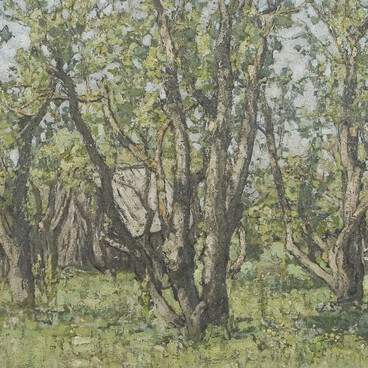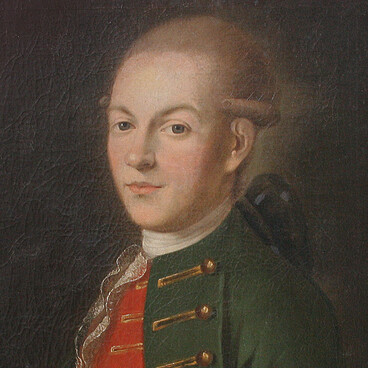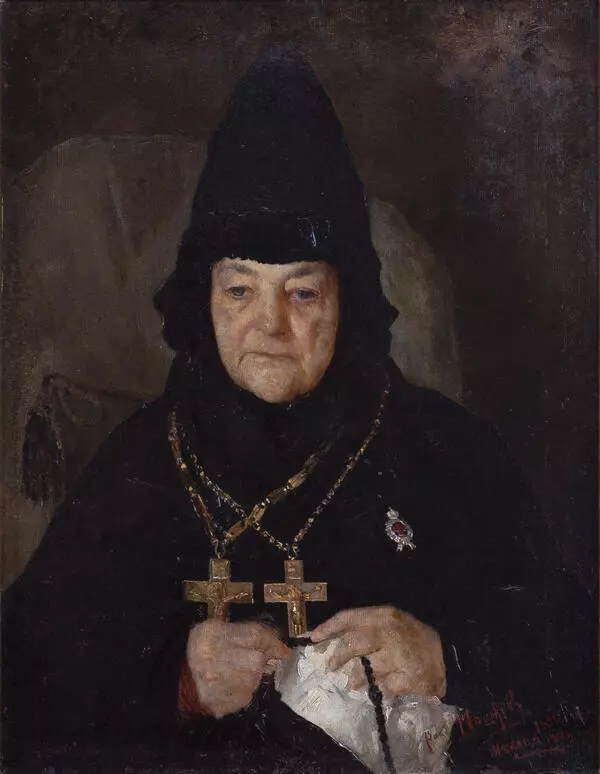Vasily Nikitich Meshkov was a painter and graphic artist, mainly a portraitist, a master of genre paintings, and a landscape painter.
He was born in 1867 in a simple working-class family. His father worked in a local bakery, and his mother was engaged in household chores and raising children. He orphaned early. As a child, he began working in the Zadonsky monastery, where he painted icons. He received his first drawing lessons from the famous Yelets artist Mikhail Nikolaevich Gorshkov. He studied at the Moscow School of Painting, Sculpture and Architecture under Pavel Desyatov, Yevgraf Sorokin, Illarion Pryanishnikov, and Vasily Polenov, and then at the St. Petersburg Academy of Arts under Pavel Petrovich Chistyakov, an outstanding Russian artist and teacher.
The artist’s career as a wonderful portraitist began in Yelets in the early 1890s.
The work of the artists of the Russian Realist movement at the turn of the 20th century was extremely diverse. In addition to their creative activity, participation in exhibitions and charity work, many of them successfully proved themselves as teachers. Vasily Nikitich also taught at his own school of painting and drawing in Moscow from 1892 to 1917 and at the Academy of Arts in Leningrad from 1937 to 1940. Among his students were Nikolay Terpsikhorov, Boris Yakovlev, Vasily Yakovlev, Pyotr Shukhmin, as well as the artist’s son, the landscape painter Vasily Meshkov.
He created genre paintings in the spirit of the late Wanderers, which is vividly evident in the canvas “Loneliness”, created in 1900. With great skill, he conveyed the décor of the room, which helps to reveal the idea and message of the work. In this canvas, the inner depressed state of the depicted man can be acutely felt, it is expressed in his slightly relaxed posture of humility; with his eyes closed, he seems to be addressing himself, his memories and echoes of the past. The image is built on the contrast of a dim, half-empty room, symbolizing the existential anxiety of the man, and the sunlit landscape full of life in the window. The motif of the open window is an important mythopoetic symbol that indicates a person’s connection with the outside world, in this case it acts as an image of light, clarity and hope in the future.
He was born in 1867 in a simple working-class family. His father worked in a local bakery, and his mother was engaged in household chores and raising children. He orphaned early. As a child, he began working in the Zadonsky monastery, where he painted icons. He received his first drawing lessons from the famous Yelets artist Mikhail Nikolaevich Gorshkov. He studied at the Moscow School of Painting, Sculpture and Architecture under Pavel Desyatov, Yevgraf Sorokin, Illarion Pryanishnikov, and Vasily Polenov, and then at the St. Petersburg Academy of Arts under Pavel Petrovich Chistyakov, an outstanding Russian artist and teacher.
The artist’s career as a wonderful portraitist began in Yelets in the early 1890s.
The work of the artists of the Russian Realist movement at the turn of the 20th century was extremely diverse. In addition to their creative activity, participation in exhibitions and charity work, many of them successfully proved themselves as teachers. Vasily Nikitich also taught at his own school of painting and drawing in Moscow from 1892 to 1917 and at the Academy of Arts in Leningrad from 1937 to 1940. Among his students were Nikolay Terpsikhorov, Boris Yakovlev, Vasily Yakovlev, Pyotr Shukhmin, as well as the artist’s son, the landscape painter Vasily Meshkov.
He created genre paintings in the spirit of the late Wanderers, which is vividly evident in the canvas “Loneliness”, created in 1900. With great skill, he conveyed the décor of the room, which helps to reveal the idea and message of the work. In this canvas, the inner depressed state of the depicted man can be acutely felt, it is expressed in his slightly relaxed posture of humility; with his eyes closed, he seems to be addressing himself, his memories and echoes of the past. The image is built on the contrast of a dim, half-empty room, symbolizing the existential anxiety of the man, and the sunlit landscape full of life in the window. The motif of the open window is an important mythopoetic symbol that indicates a person’s connection with the outside world, in this case it acts as an image of light, clarity and hope in the future.






